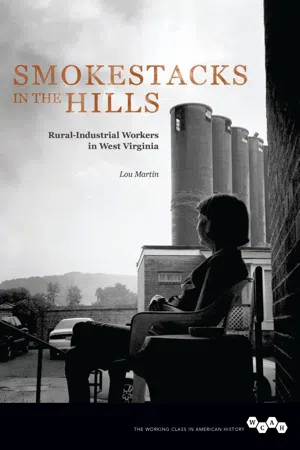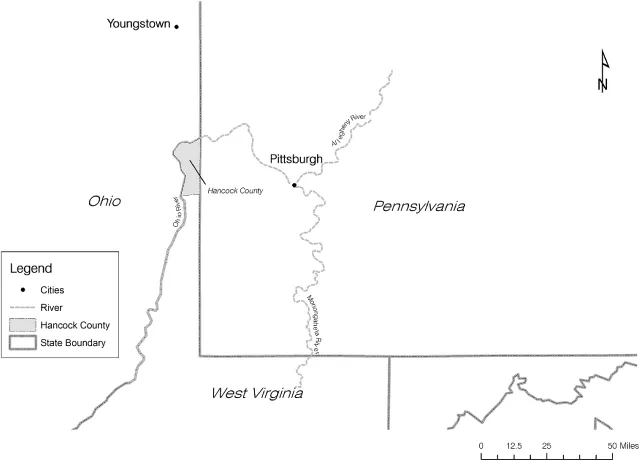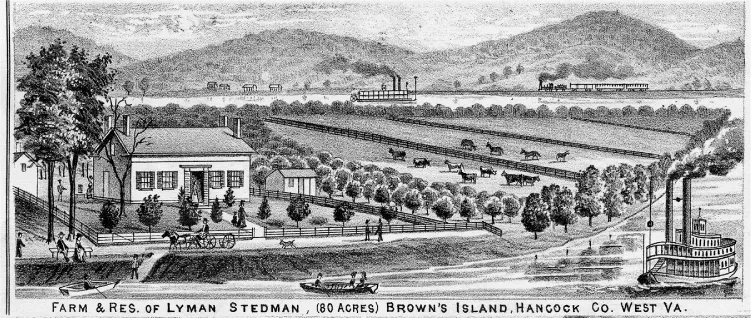![]()
CHAPTER 1
A RURAL PLACE AND A RURAL PEOPLE
In the 1880s, Lyman Stedman spent most of his days doing chores on his farm on Brown’s Island, a sliver of land in the Ohio River within the boundaries of Hancock County, West Virginia. Like many in the northern panhandle of the Mountain State, Stedman was a Republican who favored modernization, and he had served as a delegate in the West Virginia state legislature in the 1870s. Now in his fifties, he spent his time planting corn, hauling manure out to the fields, and mowing hay. On Sundays, the family attended the Methodist Episcopal Church, but the rest of the week, Lyman and his twenty-six-year-old son, Audubon, attended to the numerous tasks their farm required of them. In his diary, the patriarch of the Stedman family seldom mentioned his wife, Emily, his daughters, Blanche and Mabel, or his younger sons, Sedgwick or Chester, evidence that in many ways they lived separate lives. As a family, the Stedmans organized the tasks of agricultural production by gender, produced most of the food they ate, and sold surpluses at local markets and to merchants.
Before the rapid industrialization of Hancock County, farming dominated the economy and defined the lives of residents of these rolling hills along the Ohio River. Most of the local yeoman farmers like Stedman raised sheep, grew grain for their livestock, and tended apple orchards. In the late nineteenth century, the rural culture of farming families privileged local institutions over distant bureaucracies such as state agencies and large corporations. The habits and values of this rural existence shaped their survival strategies and notions of work, community, and politics in ways that long outlived the county’s reliance on agriculture. Therefore, an examination of the rural culture of this place prior to industrialization helps us understand local rural-industrial workers in the twentieth century.
MAP 1. Hancock County and the region
Source: Jessica Brewer
Hancock County sits in a bend in the Ohio River about forty miles west of Pittsburgh, Pennsylvania, where the waterway forms the border between Ohio and West Virginia. This land of green rolling hills, small creeks, and large stands of oak, maple, and pine trees held great potential for the farming people that migrated westward in the 1750s. Early settlers to this region traveled across the Allegheny Mountains from eastern Pennsylvania, eastern Virginia, and Maryland. Many of them originated in the British Isles and used techniques passed down through the generations to carve farms out of frontier forests. In the early 1770s, at the age of four, Joseph Doddridge migrated to the area with his family. He later remembered how difficult it was to make “new establishments in a remote wilderness,” especially because they had to violently displace the Delaware, Mingo, and Shawnee Indian nations, who lived and hunted there. Fighting a war and eking out an existence from the fields and forests pushed these pioneers to the limits of their endurance. Doddridge and his generation transformed the land during their lifetimes, clearing timber, planting crops, raising livestock, and laying the foundation for an economy that rested on commercial agriculture. So much had changed by 1824, Doddridge wrote, that the countryside’s former appearance was “like a dream.” As the pioneer looked around, he found that his father’s little cabin no longer existed and the “little field and truck patch, which gave him a scanty supply of coarse bread and vegetables,” had been “swallowed up in the extended meadow, orchard, or grain field.” The old pioneer was now “surrounded by the busy hum of men, and the splendor, arts, refinements and comforts of civilized life.”
Farmers in the panhandle secured their food supply first but also participated in market exchanges. In the early 1800s, they grew potatoes, beans, and corn to eat and wheat to sell to local flour mills. By 1830, the northern panhandle of what was then western Virginia was an important center of flour milling, and merchants shipped between thirty and forty thousand barrels of flour down the river to New Orleans every year. Growing wheat for external markets, however, pushed the soil of northern panhandle farms to its limit, and soil exhaustion and erosion—not to mention declining grain prices—forced farmers to reconsider the crop. They shifted their efforts from growing wheat to planting apple trees and raising sheep. Raising sheep had several advantages. Sheep naturally fertilized the soil and prepared pastures for plowing, and the price of wool was on the rise. Also, many area farmers had either raised sheep in the British Isles before migrating over the Allegheny Mountain or came from families who had a tradition of raising sheep in Ireland and America. These farmers observed that the climate, soil, and topography of this region were ideally suited to sheep. While the average farm in the northern United States in the mid-nineteenth century only had 11 to 12 sheep, a survey of the farms in Hancock and neighboring counties revealed that these farms averaged 157. Hancock farmers sold their wool to the woolen mills downriver in Wellsburg, West Virginia, and Steubenville, Ohio. During the 1860s and 1870s, New England mills bought the greatest percentage of wool from West Virginia’s northern panhandle.
Apples were another important crop for the nineteenth-century commercial farmers of Hancock County. One early settler, Jacob Nessly, planted fifty acres of apple and pear trees and made fruit brandies with the produce. His farm was situated at a convenient landing on the Ohio River, and his distilling business netted him and his heirs a small fortune. By the time of his death, he owned some five thousand acres of land along a five-mile stretch of the river. His profitable example undoubtedly encouraged others, as did amenable conditions like cool breezes off the river and rich soils. By the 1880s, it was common for Hancock County farmers to tend two or three hundred apple trees on their land, but more ambitious entrepreneurs had orchards of as many as eighteen thousand trees. They also experimented with developing new varieties of apples. One farmer in neighboring Brooke County became renowned for his “Golden Grimes” apple, while Hancock apple growers became known for their “Willow Twig.” The 1896 harvest in Hancock yielded 300,000 bushels of apples, attesting to the decades of labor needed to grow and maintain the orchards.
While most sold their farm products to merchants connected to national markets, local farmers spent considerable time producing for their own subsistence as well. The diversity of crops and animals they raised was part of a “subsistence-surplus” strategy. In 1880, Lyman Stedman and his family farmed one hundred acres of improved land. They had a six-acre apple orchard of two hundred trees that produced 450 bushels of apples, and their 35 sheep produced 200 pounds of fleece. That year, they also harvested 800 bushels of Indian corn, 300 bushels of wheat, 150 dozen eggs, and 25 bushels of Irish potatoes; they kept five horses, five milk cows, and about 75 chickens and made 300 pounds of butter and 40 gallons of molasses. Similarly, Jane Adair Truax owned a farm in nearby Hollidays Cove. She and her family tilled 97 acres of ground and had a seven-acre orchard. In 1880, they harvested 300 bushels of Indian corn, 200 bushels of wheat, 15 dozen eggs, and 30 bushels of Irish potatoes. Unlike the Stedmans, who had no hired hands, Truax paid $25 that year for help on the farm. It is likely that she hired someone to help her churn the incredible 900 pounds of butter that her farm produced, which would have netted her a considerable amount of cash. Sometimes twelve- to fourteen-year-old girls would come to stay with a family and help out with domestic manufacture. The Truax family also kept 43 sheep whose wool they could take to market as well.
James Dietz grew up in the early 1900s in central West Virginia on a farm that was probably very similar to the farms of Hancock County at that time. His childhood memories suggests that many farming families still practiced a blend of subsistence and market activities and that they still tried to limit purchases by making products themselves or doing without. He recalled, “Both Dad and Mother were hard workers and scrupulous about the way they spent their money. They bought only bare necessities.” Farmers called this “making do,” and it became a central tenet of farming culture that lasted well into the twentieth century. In fact, the habits and values of making do would remain important to rural-industrial workers in the mill and pottery towns of Hancock County in the mid-twentieth century.
Commercial farming in Hancock County reached its pinnacle in the last quarter of the nineteenth century. In 1879, one observer remarked that a husbandman in Hancock County could rejoice at the productiveness of his acres and “smile at the long waving green that covers his pasture fields. His cattle are sleek and fat, sheep in good order, with promising abundance of wool of the finest quality yearly.” The county’s towns and villages were gathering places for farmers. The villages of New Manchester and Hollidays Cove contained post offices, hardware stores, and blacksmiths that catered to farmers. In 1868, Hollidays Cove had 250 inhabitants, two wagon makers, two shoe shops, a drug store, and three churches. The only manufacturing of significance occurred in New Cumberland, also known as “Brickyard Bend.” New Cumberland started as a convenient riverfront landing and developed into a center for brick manufacturing in the late 1830s and the 1840s. A particularly rich vein of Kittanning Fire Clay lay underneath Hancock County and adjacent areas. Manufacturers began clay mining operations in the county’s hills and along the river. They shipped bricks down the Ohio and the Mississippi and sold them in towns all along the way. While the burgeoning western markets stimulated the mining and shipping business, the brickyard crews remained small, four or five men. Even in the late 1800s, brick manufacturing only employed several dozen and drew few farmers away from their land.
FIGURE 1. Lyman Stedman farm and residence, 1877
Source: West Virginia and Regional History Center, WVU Libraries
Farming Families, Work, and Independence
Many of the family dynamics of Hancock County farmers rested on centuries of tradition as well as adaptations to their setting in northern West Virginia. They organized their work, planned their estates, and participated in the market economy, all designed to achieve a particular sense of independence.
Men and women largely worked in separate spheres, spending most of their day on different parts of the farm and at tasks assigned by gender. Within the family hierarchy, the father stood at the head and in many ways controlled the lives of the other members of the household. His dependents by law and by custom included not only his children but also his wife, and the father held title to the family’s property and was entitled to the fruits of the labor of his family and any servants. Parents socialized their children from an early age to respect the gender boundaries of their society, instructing them on what it meant to be manly and womanly.
In northern states in the nineteenth century, yeoman farmers such as Lyman were much celebrated for their independence. Many believed that farmers made good citizens because, unlike manufacturers, they were not dependent on the whims of the market. Americans also equated family farming with egalitarianism. In 1815, a minister in neighboring Brooke County waxed about this aspect of life in his community:
I cannot speak too highly of the advantages that the people in this country enjoy in being delivered from a proud and lordly aristocracy.… I have had my horse shod by a legislator, my horse saddled, my boots cleaned, my stirrup held by a senator. Here is no nobility but virtue; here there is no ascendance save that of genius, virtue and knowledge. The farmer here is lord of the soil, and the most independent man on earth.
Having emigrated from County Antrim, Ireland, this minister knew from experience what it was like to live under a “lordly aristocracy.” The yeomanry of western Virginia also contrasted with the wealthy planters of the Tidewater, particularly in that yeomen owned relatively modest tracts of land and relied on family labor rather than slave labor. But the livelihood and the celebrated independence of the yeoman farmer rested on his ability to control the labor of his “dependent” family members and to reap the fruits of that labor. Therefore, the patriarchal system, which perpetuated inequality within the family, formed the foundation of the “egalitarian” yeoman’s independence.
The men and women of nineteenth-century Hancock County were socialized into gendered roles on the family farm. Hancock County farmers treated their sons like apprentices, training them from an early age. In 1907, the editor of the New Cumberl...


